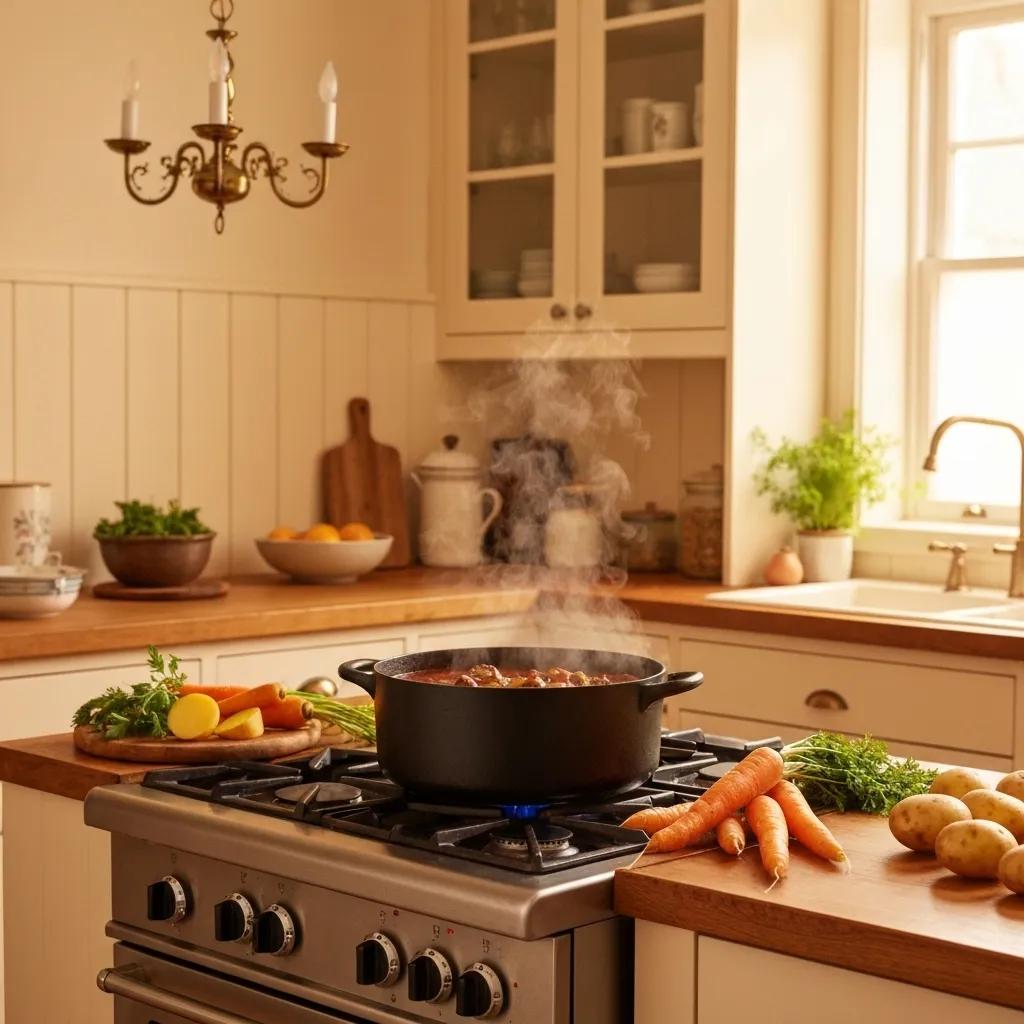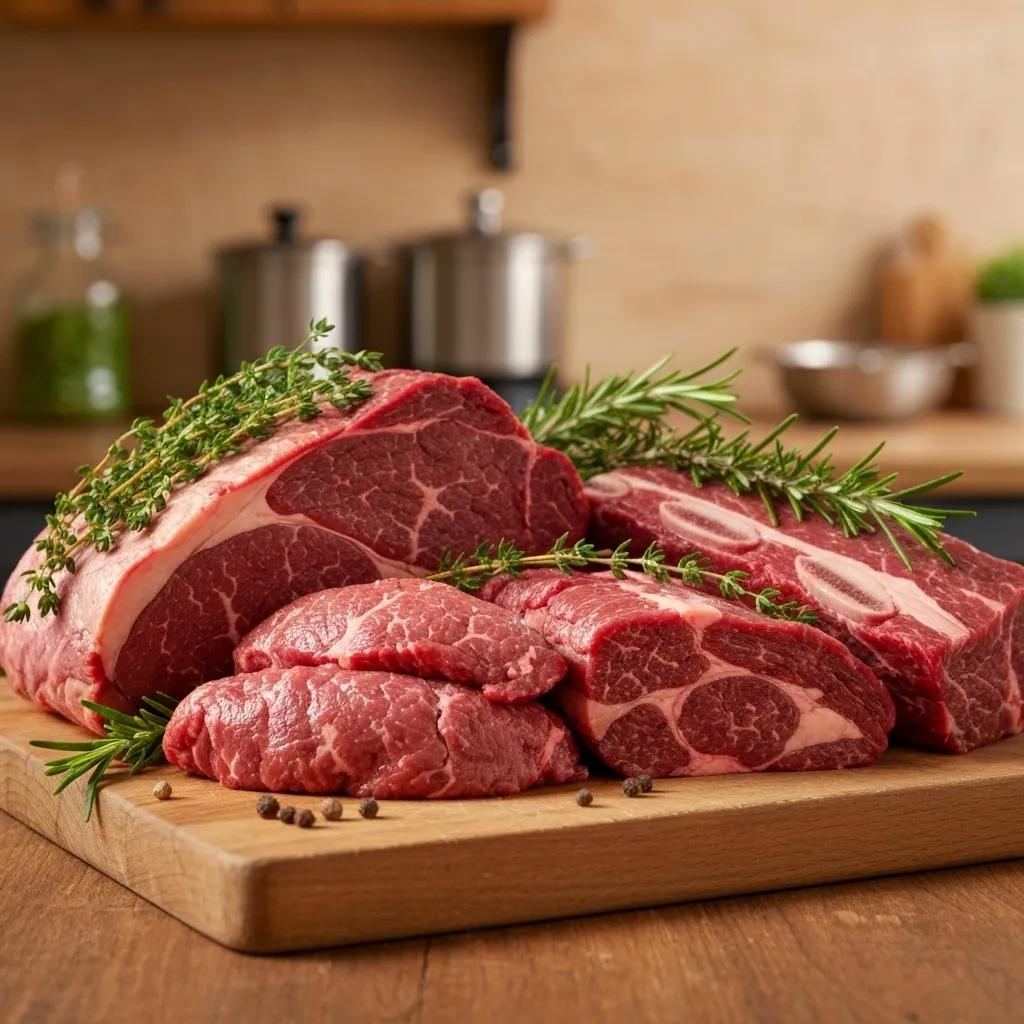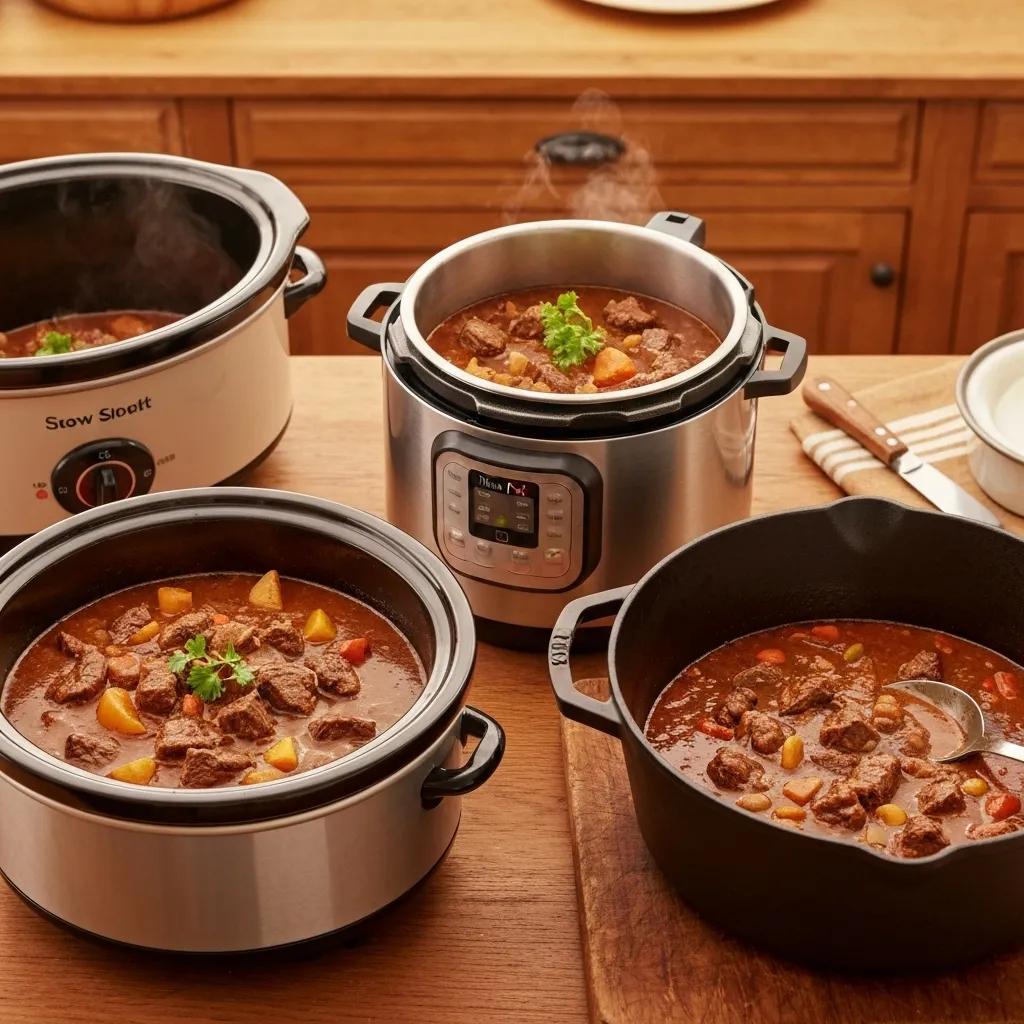The Ultimate Guide to Crafting Beef Stew Recipes

Best Beef Stew and Recipe Guide: How to Choose Cuts, Cook, and Create Hearty Stews

A perfectly rich beef stew begins with the right cut of meat and a foolproof cooking plan that turns connective tissue into silky gelatin. Many home cooks struggle with tough, flavorless chunks or watery broth, but mastering cut selection, searing techniques, seasoning balance, and cooking methods solves those pain points. This guide covers:
- Selecting and comparing top stew cuts
- An easy, flavor-packed recipe with step-by-step instructions
- Slow cooker, Instant Pot, and Dutch oven techniques
- Secrets for ideal tenderness and broth thickening
- Regional variations and serving ideas
- Storage best practices and sourcing premium beef from Capital Farms
With this roadmap, readers aged 25–55 will achieve consistent, restaurant-quality results and discover where to buy sustainably raised beef.
What Are the Best Beef Cuts for Stew?

Choosing the right beef cut sets the foundation for a succulent stew because marbling and collagen convert to gelatin, creating tender meat and a rich mouthfeel. Below is a comparison of three popular stew cuts highlighting fat content, collagen level, and ideal cooking time.
| Cut | Marbling | Collagen Level | Optimal Cook Time |
|---|---|---|---|
| Chuck Roast | High | Very High | 2–3 hrs braise |
| Stew Meat | Medium | Medium | 1.5–2 hrs simmer |
| Short Ribs | Very High | Very High | 3–4 hrs braise |
Each cut offers unique benefits: chuck roast balances affordability with tenderness, stew meat provides convenient cubes, and short ribs deliver maximum richness.
Why Is Chuck Roast Ideal for Beef Stew?
Chuck roast is a shoulder cut rich in collagen that breaks down into gelatin during long, slow cooking, yielding melt-in-your-mouth morsels. Its even fat distribution enhances flavor and prevents dryness, and its moderate price makes it a go-to choice for both novices and seasoned cooks.
How Does Stew Meat Compare to Other Cuts?
Stew meat consists of pre-cubed pieces from various primal cuts trimmed to uniform size, which cooks faster but contains less collagen than chuck. The convenience of consistent cubes simplifies preparation, though the broth may lack the depth achieved by higher-collagen cuts.
Are Short Ribs Suitable for Hearty Beef Stew?
Yes, short ribs provide exceptional flavor and a silky texture thanks to abundant fat and connective tissue. They require longer braising and a higher budget, but they deliver a restaurant-quality experience when patience meets premium ingredients.
What Makes Capital Farms Beef Perfect for Stewing?
Grass-fed and ethically raised, Capital Farms beef combines superior marbling with traceable farm-to-table transparency, ensuring consistent tenderness and robust flavor. This high-quality beef responds exceptionally well to slow cooking and pressure braising, transforming tough fibers into juicy perfection. For premium cuts that set your stew apart, explore Capital Farms – Premium Beef, Farm to Table.
How Do You Make an Easy and Flavorful Beef Stew Recipe?
An easy beef stew layers flavor by searing meat, sautéing aromatics, deglazing with wine or broth, then simmering until tender. This approach creates a balanced, savory dish that warms the soul.
What Are the Essential Ingredients for Hearty Beef Stew?
A classic stew relies on five core categories to build depth:
- Beef: 2 lbs chuck roast, cut into 1½-inch cubes
- Vegetables: Carrots, potatoes, onions, celery, and peas
- Aromatics & Seasonings: Garlic, thyme, bay leaves, salt, and pepper
- Liquids: Beef broth and a splash of red wine or Worcestershire sauce
- Thickener: Flour for dredging or cornstarch slurry
How Do You Prepare and Brown Beef for Maximum Tenderness?
Browning beef triggers the Maillard reaction, locking in juices and creating savory compounds.
Effects of Searing Cooking on Sensory and Physicochemical Properties of Beef Steak
A study on beef steak preparation found that searing at high temperatures significantly improves the overall flavor and roasted meat aroma due to the Maillard reaction, a non-enzymatic browning process. However, this searing technique did not show a significant impact on the juiciness, water content, or cooking loss of the beef.
This research verifies the article's claim that browning beef through searing triggers the Maillard reaction, which is crucial for developing deep, savory flavors in beef stew.
- Pat Dry: Remove surface moisture with paper towels.
- Season: Toss cubes with salt, pepper, and a light dusting of flour.
- Sear in Batches: Heat oil over medium-high heat and brown each side without overcrowding.
Proper searing lays the groundwork for deep flavor and tender results when braising.
What Are Step-by-Step Instructions for Classic Beef Stew?
Follow these steps for a foolproof, classic stew:
- Sauté Aromatics: Cook onions, garlic, and celery in oil until softened.
- Brown Beef: Remove aromatics, then sear seasoned beef cubes until crusted.
- Deglaze: Add red wine or a splash of broth, scraping up browned bits.
- Combine & Simmer: Return aromatics and beef to pot, add vegetables and broth.
- Braise: Cover and cook on low heat (stovetop/oven) or slow cooker until meat yields to a fork.
These sequential actions ensure each layer of flavor develops fully.
How Can You Thicken and Enhance Beef Stew Broth?
Broth can be thickened and enriched using several techniques:
- Flour Dredge: Coat beef before searing to naturally thicken cooking liquid.
- Cornstarch Slurry: Stir 1 Tbsp cornstarch into cold water, then whisk into simmering stew.
- Reduction: Simmer uncovered for 10–15 minutes to concentrate flavors and body.
Selecting the right method balances silky texture with clear, vibrant flavors.
What Are the Best Cooking Methods for Beef Stew?

Cooking method dictates timing, convenience, and flavor intensity. Slow cooker, Instant Pot, and Dutch oven each offer distinct advantages for transforming tough cuts into tender stew.
How to Make Slow Cooker Beef Stew with Tender Results?
Slow cooker stews benefit from gentle, all-day heat that breaks down collagen without monitoring:
- Layer seared beef, aromatics, vegetables, and broth in cooker.
- Cook on Low for 8 hours or High for 4 hours.
This hands-off approach yields reliably tender meat and deeply infused flavors.
How Does Instant Pot Beef Stew Save Time Without Sacrificing Flavor?
Pressure cooking condenses hours of braising into a fraction of the time by raising the boiling point of liquid:
- Sauté onions and beef using the Sauté function.
- Seal lid, cook on high pressure for 35 minutes, then natural release.
The result is a fully tender stew under one hour, with no compromise on richness.
Why Use a Dutch Oven for Traditional Beef Stew?
A Dutch oven’s cast-iron construction provides even heat distribution for stovetop or oven braising:
- Sear beef and sauté aromatics in the pot.
- Add liquids and vegetables, then transfer to a 325 °F oven for 2–3 hours.
This method merges classic technique with hands-on control over texture.
What Are the Key Differences Between These Cooking Methods?
| Method | Cook Time | Hands-Off Level | Flavor Depth | Best For |
|---|---|---|---|---|
| Slow Cooker | 4–8 hours | Very High | Moderate | Busy schedules |
| Instant Pot | ~1 hour | Medium | High | Quick dinners |
| Dutch Oven | 2–3 hours (oven) | Low | Very High | Traditional technique |
How Do You Achieve Perfect Tenderness in Beef Stew?
Tenderness arises when collagen melts into gelatin under consistent heat and moisture, transforming tough fibers into succulent bites.
Understanding Collagen Breakdown in Slow Cooking: How Slow Cooking Affects Meat Texture and Achieves Perfect Tenderization for Culinary Professionals and Food Science Enthusiasts
Research indicates that slow cooking, characterized by gentle and consistent heat, facilitates the gradual breakdown of collagen into gelatin at temperatures around 154°F (68°C). This transformation enhances the meat's moisture content and contributes to a tender texture, while also preventing muscle fibers from contracting too rapidly, which is essential for achieving a desirable mouthfeel.
This research directly supports the article's explanation of how slow cooking methods and the breakdown of collagen contribute to the tenderness of beef stew.
What Role Does Browning Beef Play in Tenderness and Flavor?
Browning initiates the Maillard reaction, creating flavorful crusts and aroma compounds that enhance perceived tenderness. While it doesn’t physically tenderize, it lays a foundation of depth that elevates the braising phase.
How Long Should You Cook Beef Stew for Optimal Tenderness?
Cooking times vary by method but follow these guidelines:
- Slow Cooker: 8 hours on low or 4 hours on high
- Instant Pot: 35 minutes at high pressure, plus release
- Dutch Oven (oven): 2–3 hours at 325 °F
What Are Tips to Avoid Overcooking or Drying Out Beef?
- Maintain adequate liquid levels, topping up with broth as needed.
- Keep a steady, low simmer rather than a rolling boil.
- Test doneness 15 minutes before the target time to prevent mushy meat.
These practices protect juiciness and texture throughout cooking.
How Does Connective Tissue Breakdown Affect Stew Texture?
As collagen converts to gelatin, it creates a silky mouthfeel and naturally thickens the broth. Recognizing this transformation helps you adjust cook time and liquid ratios for ideal body and consistency.
What Are Popular Variations and Regional Beef Stew Recipes?
Beef stew adapts to local ingredients and traditions, offering global flavor profiles that expand beyond the classic pot.
What Makes Classic Irish Beef Stew Unique?
Irish stew often incorporates stout or Guinness, pearl onions, and a simple flour dredge. The beer’s malt sweetness deepens umami, while tender root vegetables absorb its distinctive character.
How Is Hungarian Goulash Different from Traditional Beef Stew?
Hungarian goulash highlights paprika and caraway seeds with leaner cuts, producing a brighter, spice-forward broth. Shorter simmer times prevent the paprika from turning bitter.
What Are Easy One-Pot Beef Stew Variations?
One-pot versions streamline cleanup by searing, sautéing, and simmering in the same vessel. Examples include beef and barley stew, Mexican-style chili beef stew, or coconut curry beef stew.
How Can You Customize Beef Stew with Dumplings or Additional Vegetables?
Adding drop-biscuit dumplings boosts heartiness, while seasonal vegetables—like turnips, parsnips, or winter squash—introduce freshness and color. These custom touches create a personalized comfort dish.
How Should You Store and Serve Beef Stew for Best Results?
Proper handling and reheating preserve flavor, texture, and safety for leftovers and make-ahead meals.
What Are the Best Practices for Storing Leftover Beef Stew?
Refrigerate cooled stew in airtight containers for up to 4 days. For longer storage, freeze portions in zip-top bags or jars for up to 3 months, removing excess air to minimize freezer burn.
How Do You Reheat Beef Stew Without Losing Flavor or Texture?
Gently reheat on low heat, stirring occasionally and adding a splash of broth or water to restore moisture. Oven reheating at 300 °F in a covered dish also preserves juiciness.
What Are Recommended Side Dishes and Pairings for Beef Stew?
Serve with crusty bread, creamy mashed potatoes, buttered egg noodles, or polenta to soak up the rich broth. A crisp green salad and a glass of robust red wine complement the meal.
Can You Freeze Beef Stew and How Does It Affect Quality?
Freezing halts bacterial growth and preserves nutrients; properly sealed stew retains near-fresh texture. Thaw slowly in the refrigerator overnight for best results.
Where Can You Find Capital Farms Beef for Your Beef Stew Recipes?
Capital Farms sources premium, grass-fed beef directly from sustainable pastures, delivering traceable quality and flavor that elevates any stew.
How to Shop for Capital Farms Chuck Roast and Stew Meat Online?
Visit the Capital Farms – Premium Beef, Farm to Table homepage to browse chuck roast and stew meat offerings. Select the desired cut, choose your quantity, and checkout for farm-fresh delivery.
Why Choose Sustainable, Grass-Fed Beef for Your Stew?
Grass-fed beef provides a leaner profile, higher omega-3 content, and naturally enhanced marbling, resulting in deeper flavor and healthier nutrition compared to conventionally raised beef.
How Does Capital Farms Ensure Quality and Transparency?
Capital Farms employs pasture-raised cattle, antibiotic-free protocols, and full traceability from birth through butchering. Regular audits and direct farm-to-door sales guarantee integrity at every step.
What Are Customer Testimonials About Capital Farms Beef Stew Success?
Home chefs praise the consistent tenderness and robust taste achieved with Capital Farms beef, noting that even amateur cooks impress dinner guests with melt-in-your-mouth results.
A well-planned stew begins with the perfect cut, methodical preparation, and quality ingredients that transform tough meat into a flavorful, comforting feast. By applying these selection tips, cooking techniques, and recipe steps—and choosing sustainably raised beef from Capital Farms—anyone can master the art of hearty, restaurant-worthy beef stew. Enjoy the process, experiment with variations, and discover why the right beef makes all the difference.
